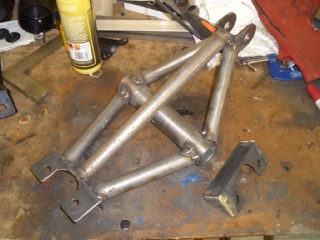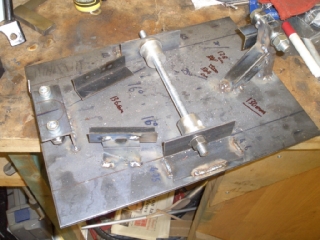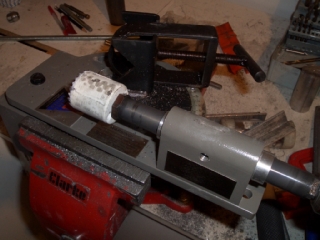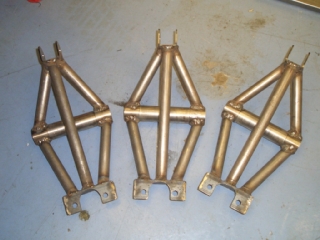And here, as they old saying goes, is one I made earlier. I've turned
down the central section of the central tube on the lathe (probably pointless, but what the hell) to replicate
the fabricated central tube of the bent rocker arm. The damper mount bracket isn't something I've made - I bought
it from 3GE components, who make parts for the new Locostesque Haynes Roadster. It's their part
number SUS2, and at £1.90 each it makes making up suspension brackets look like a thoroughly unworthwhile
job. Even better, their website works, they take payment via Paypal, and they deliver stuff very promptly, so I
suspect I'll be using them again.
This top rocker arm isn't quite finished. It's only tack-welded in places, and there are a couple of reinforcing
plates to go in the balljoint mount on the left hand side - a mount with the side plates welded in place is on
the right hand side of the photo.
The tubes on the top rocker other than the central tube are the usual 22mm/7/8" 16 gauge CDS tubing which
Tim and I use for wishbones. It's fatter than the tubes used in the standard Fisher wishbones, but if previous
experience is anything to go by, it'll be considerably thinner wall thickness. I'll try weighing one of my rocker
arms and one of the Fury manufactured ones to see who they compare.
As usual with replacement parts, I've aimed for an accurancy of +/- .5mm, on the basis that this is significantly
more accurate than the standards to which the chassis was constructed. The rocker arms I've made are certainly
an accurate reproduction of the Fisher ones - they even accurately replicate the fact that on the Fisher top rocker
arm the balljoint mount isn't mounted squarely when compared to the central tube... |
 |



